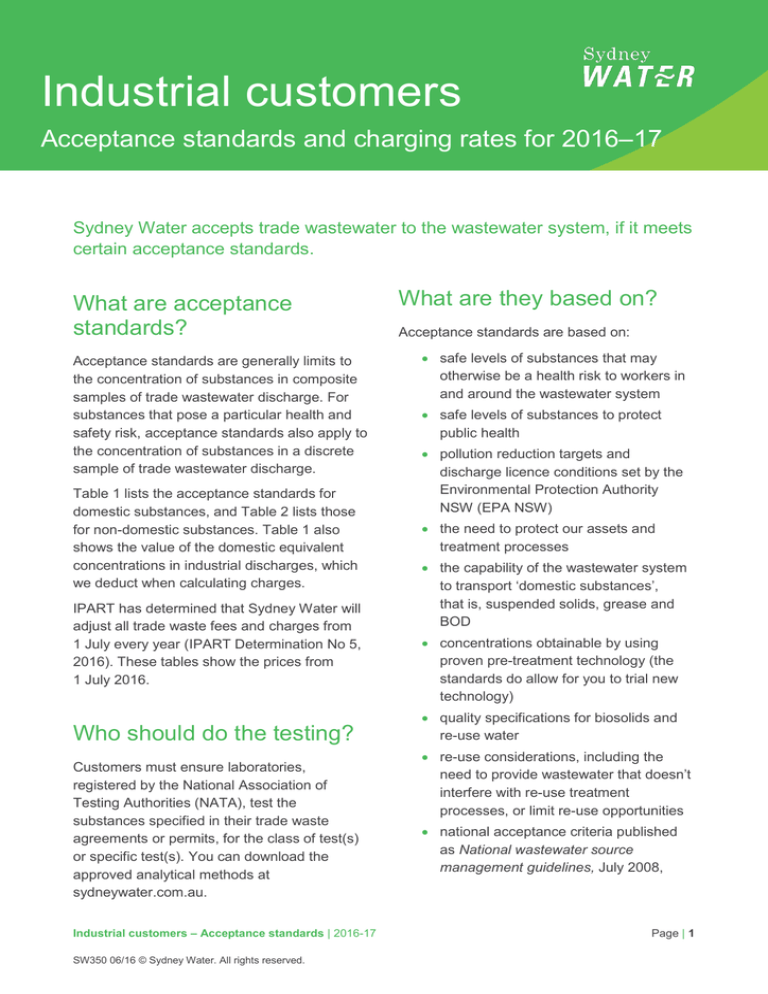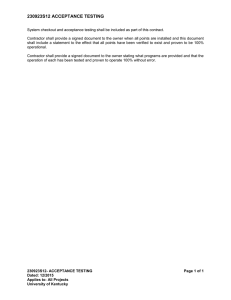
Industrial customers
Acceptance standards and charging rates for 2016–17
Sydney Water accepts trade wastewater to the wastewater system, if it meets
certain acceptance standards.
What are acceptance
standards?
Acceptance standards are generally limits to
the concentration of substances in composite
samples of trade wastewater discharge. For
substances that pose a particular health and
safety risk, acceptance standards also apply to
the concentration of substances in a discrete
sample of trade wastewater discharge.
Table 1 lists the acceptance standards for
domestic substances, and Table 2 lists those
for non-domestic substances. Table 1 also
shows the value of the domestic equivalent
concentrations in industrial discharges, which
we deduct when calculating charges.
IPART has determined that Sydney Water will
adjust all trade waste fees and charges from
1 July every year (IPART Determination No 5,
2016). These tables show the prices from
1 July 2016.
Who should do the testing?
Customers must ensure laboratories,
registered by the National Association of
Testing Authorities (NATA), test the
substances specified in their trade waste
agreements or permits, for the class of test(s)
or specific test(s). You can download the
approved analytical methods at
sydneywater.com.au.
Industrial customers – Acceptance standards | 2016-17
SW350 06/16 © Sydney Water. All rights reserved.
What are they based on?
Acceptance standards are based on:
safe levels of substances that may
otherwise be a health risk to workers in
and around the wastewater system
safe levels of substances to protect
public health
pollution reduction targets and
discharge licence conditions set by the
Environmental Protection Authority
NSW (EPA NSW)
the need to protect our assets and
treatment processes
the capability of the wastewater system
to transport ‘domestic substances’,
that is, suspended solids, grease and
BOD
concentrations obtainable by using
proven pre-treatment technology (the
standards do allow for you to trial new
technology)
quality specifications for biosolids and
re-use water
re-use considerations, including the
need to provide wastewater that doesn’t
interfere with re-use treatment
processes, or limit re-use opportunities
national acceptance criteria published
as National wastewater source
management guidelines, July 2008,
Page | 1
WSAA.
Table 1: Acceptance standards, domestic equivalents and charging rates for domestic substances
Substance
Acceptance
standard
(mg/L)
Domestic
equivalent
(mg/L)
Note
Charging rate
($/kg)
BOD5 – primary treatment
230
1
0.285 + (0.123 x
[BOD mg/L]/600)
BOD5 – secondary/tertiary treatment
230
1
1.851 + (0.123 x
[BOD mg/L]/600)
Suspended solids – primary treatment
600
200
0.517
Suspended solids – secondary/tertiary
treatment
600
200
1.498
Grease – primary treatment
110
50
2
0.467
Grease – secondary/tertiary treatment
200
50
2
1.431
Nitrogen
150
50
4
1.697
Phosphorus
50
10
4
6.085
Ammonia*
100
35
3, 5
-
Sulphate
2,000
50
Total dissolved solids (ocean systems, no
discharge limitation)
10,000
450
12
-
Total dissolved solids (inland and ocean
systems with limitation)
500
450
12
-
Total dissolved solids (inland and ocean
systems with advanced treatment to
remove TDS)
10,000
450
12
-
-
* For substances that pose a particular health and safety risk, apply acceptance standards to the concentration of
substances in a discrete sample of trade wastewater discharge as well as in composite samples.
Industrial customers – Acceptance standards | 2016-17
Page | 2
Trade waste requirements
Sydney Water will determine standards
for colour and interference with ultra
violet disinfection on a system-specific
basis.
There must be no fibrous material in
the trade wastewater that we believe
could obstruct or block the wastewater
system.
Non-faecal gross solids must have:
-
a maximum linear dimension of
under 20 mm
-
a maximum cross section of
6 mm
-
a quiescent settling velocity of
under 3 m/hr.
Sydney Water will negotiate radioactive
material activity rates for wastewater
discharge on a site-specific basis.
The Manager, Business Customer
Services will determine the acceptance
standards for substances other than
those listed in this fact sheet.
Sydney Water does not accept
substances (or mixtures of substances)
that cannot mix with water.
Exceeding acceptance standards can
adversely impact the beneficial re-use
of biosolids and recycled water quality.
Exceeding acceptance standards can
also represent a significant risk to staff
safety and the environment.
Table 2 Acceptance standards for non-domestic substances
Substance
Acetaldehyde*
Acceptance standard (mg/L)
Note
5
5
Acetone*
400
5
Aluminium
100
Arsenic
1
Barium
5
Boron
100
Bromine*
5
Cadmium
1
Chlorinated phenolics
Chlorine*
Industrial customers – Acceptance standards | 2016-17
5
0.05
6
10
5
Page | 3
Substance
Acceptance standard (mg/L)
Chromium
3
Cobalt
5
Copper
5
Cyanide*
1
Note
7
5, 8
Fluoride
20
4
Formaldehyde*
30
5
General pesticides (excludes OC and OP)
0.1
9
Herbicides and defoliants
0.1
Iron
50
Lead
2
Lithium (specified systems only)
10
Manganese
10
Mercaptans
1
Mercury
0.03
Methyl Ethyl Ketone*
100
Molybdenum
100
Nickel
10
5
3
Organoarsenic compounds
pH*
0.1
7-10 units
Petroleum hydrocarbons (flammable)*
10
1
5, 11, 14
Benzene*
0.1
5
Toluene*
0.5
5
Ethylbenzene*
1
5
Xylene*
1
5
Industrial customers – Acceptance standards | 2016-17
Page | 4
Substance
Acceptance standard (mg/L)
Phenolic compounds (non-chlorinated)
1
Polynuclear aromatic hydrocarbons
5
Propionaldehyde*
5
Selenium
5
Silver
5
Sulphide*
5
Sulphite
Temperature*
Thiosulphate
Note
5
5
50
38° C
1
300
Tin
10
Uranium
10
Volatile halocarbons*
1
5, 13
Chloroform*
0.1
5
Perchloroethylene*
0.3
5
Trichloroethylene*
0.1
5
Zinc
5
* For substances that pose a particular health and safety risk, apply acceptance standards to the concentration of
substances in a discrete sample of trade wastewater discharge as well as in composite samples
See notes on the next page.
Want to know more?
Visit sydneywater.com.au.
Email businesscustomers@sydneywater.com.au.
Call 1300 985 227 to speak to a business customer representative.
Industrial customers – Acceptance standards | 2016-17
Page | 5
Notes to acceptance standards
1. Sydney Water will introduce acceptance
standards for a substance on a sub-system
specific basis as determined by:
how much the receiving system can
transport and treat
how corroded the sub-system is
how wastewater treatment products will be
used.
2. You must not discharge oil, fat or grease into
the wastewater system.
3. Where ammonia is present with other
nitrogenous compounds, the amount of
nitrogen in the ammonia is deducted from the
total nitrogen as measured by Total Kjeldahl
Nitrogen.
4. Fluoride, phosphorus and nitrogen limits don’t
apply where the customer’s wastewater system
is connected to a wastewater treatment plant
(WWTP) that discharges to the ocean.
5. Acceptance standards also apply to
concentrations of ammonia, benzene, bromine,
chlorine, cyanide, formaldehyde, petroleum
hydrocarbons, sulphide and volatile
halocarbons in discrete samples.
6. We will determine acceptance standards for
individual chlorinated phenolic compounds on a
catchment basis, following pollution reduction
targets set by the EPA NSW. The concentration
limit is a guide only. We may set lower limits for
individual chlorinated phenolic compounds.
7. We don’t allow discharge from cooling towers
and evaporative condensers using products
containing hexavalent chromium (chromate) or
organometallic algicides.
We don’t allow discharge of hexavalent
chromium from contaminated sites.
9. We won’t consent to any discharge of
organochlorine pesticides (including chlordane,
dieldrin and heptachlor), or organophosphorus
pesticides (including chlorpyrifos, diazinon and
malathion) into the wastewater system.
10. The limit for lithium applies only to the Rouse
Hill wastewater catchment.
11. Where flammable and/or explosive substances
may be present, the customer must
demonstrate to us that there is no possibility of
explosions or fires in the wastewater system.
We will discuss limits and charges with
individual customers, before a negotiating a
trade waste agreement. The flammability of the
discharge must never exceed five per cent of
the Lower Explosive Limit (LEL) of hexane at
25 °C. In some cases, we may require a
customer to install an LEL meter.
12. We will determine acceptance standards for
total dissolved solids on a catchment-specific
basis. A limit of 500 mg/L may apply to
customers discharging to an inland WWTP or
to one that is part of a designated re-use
system. Acceptance standards will only apply
to those customers discharging over
100 kg/day of total dissolved solids (TDS) or
greater than one per cent of the total catchment
TDS load (whichever is lower).
13. Analysis of volatile halocarbons must, at a
minimum, include methylene chloride,
chloroform, trichloroethylene and
perchloroethylene.
14. This substance is made up of several
substances including benzene, toluene,
ethylbenzene, (m+p)-xylene and o-xylene.
15. As at 1 July 2013, the limit for soluble BOD
applies only to the Smithfield catchment and
SPS 67 catchments, due to corrosion.
8. Cyanide is defined as labile cyanide amenable
to alkaline chlorination. This includes free
cyanide and those complex cyanides that are
almost entirely, or in a large degree,
dissociable, and so potentially toxic in low
concentrations.
Industrial customers – Acceptance standards | 2016-17
Page | 6





